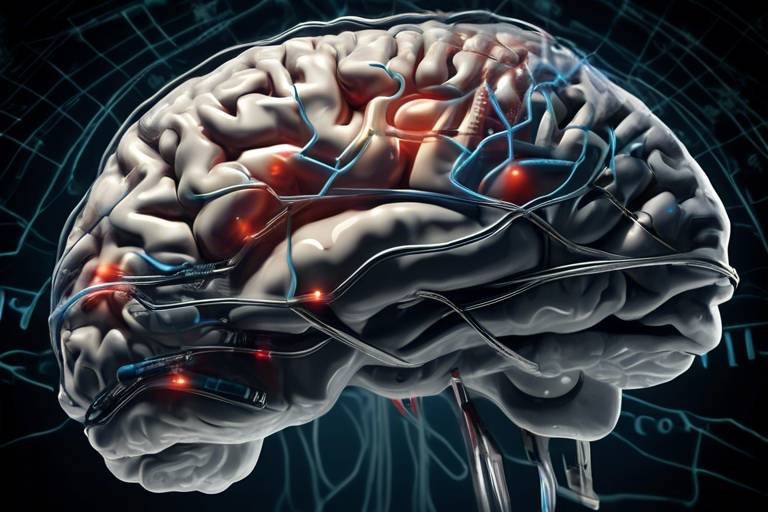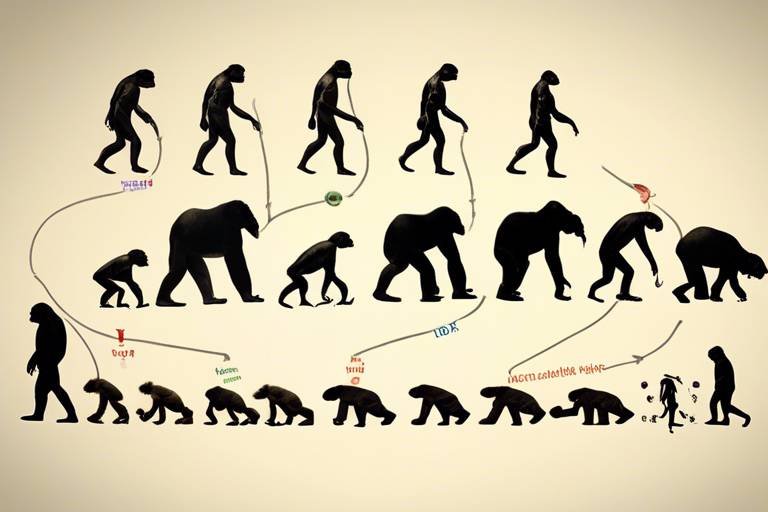Can Meditation be Analyzed Scientifically?
Meditation has long been regarded as a mystical practice, often shrouded in the aura of spirituality and personal introspection. However, in recent years, the question of whether meditation can be scrutinized through the lens of science has gained traction. The intersection of meditation and science is a fascinating realm where ancient wisdom meets modern inquiry. But can the benefits of meditation be quantified? Can we truly understand its impact on our brains and bodies through rigorous scientific methods? These questions are at the heart of a growing body of research aimed at demystifying meditation.
To tackle these questions, scientists have begun to apply various research methodologies that delve into the biological and psychological mechanisms of meditation. This exploration not only seeks to validate the anecdotal benefits reported by practitioners but also aims to uncover the underlying processes that contribute to these effects. By employing techniques such as neuroimaging and physiological measurements, researchers are painting a clearer picture of what happens in our minds and bodies when we meditate. This scientific examination opens the door to understanding how meditation can serve as a powerful tool for enhancing mental health and well-being.
One of the most intriguing aspects of this research is the potential for meditation to influence brain structure and function. Studies have shown that regular meditation can lead to changes in neural pathways, promoting emotional regulation and stress reduction. This suggests that meditation is not merely a temporary escape from reality but a practice that can fundamentally alter the way we think and feel. As we delve deeper into the science of meditation, we begin to see it as a viable complement to traditional therapeutic approaches, offering a holistic avenue for mental wellness.
However, the journey to scientifically validate meditation is not without its challenges. The variability in meditation practices, participant biases, and the need for standardized measurement tools complicate the research landscape. Each meditation technique—whether mindfulness, transcendental meditation, or loving-kindness—may yield different outcomes, making it crucial for researchers to design studies that account for these differences. Furthermore, the expectations and beliefs of participants can skew results, emphasizing the need for well-controlled studies to ensure reliable findings.
Despite these challenges, the future of meditation research looks promising. As technology advances and interdisciplinary approaches emerge, researchers are poised to uncover new insights into the mechanisms of meditation. The integration of these findings into clinical settings could revolutionize how we approach mental health treatment, making meditation an essential component of comprehensive care. With ongoing studies exploring its effectiveness for various psychological and physical conditions, the scientific community is beginning to recognize meditation not just as a practice for personal growth but as a legitimate intervention with measurable benefits.
- What are the main benefits of meditation? Meditation can reduce stress, enhance emotional well-being, improve focus, and promote overall mental health.
- How does meditation affect the brain? Meditation has been shown to alter brain structure and function, enhancing areas related to emotional regulation and cognitive processing.
- Can anyone practice meditation? Yes, meditation is accessible to everyone, regardless of age or background. There are various techniques to suit different preferences.
- How long should one meditate to see benefits? Even short sessions of 10-15 minutes can yield benefits, but consistency over time is key for lasting effects.

The Science Behind Meditation
Meditation is not just an esoteric practice reserved for monks or yoga enthusiasts; it's a fascinating intersection of biology and psychology. Understanding the biological and psychological mechanisms that underpin meditation helps clarify its effects on the mind and body, providing a solid foundation for scientific inquiry into its benefits. Imagine a symphony orchestra, where each instrument plays a crucial role in creating harmony; similarly, the brain and body work together during meditation to foster mental clarity and emotional stability.
At its core, meditation engages various brain regions, leading to changes in neural pathways that can enhance cognitive functions and emotional regulation. For instance, when you meditate, the prefrontal cortex—responsible for decision-making and self-control—becomes more active. This heightened activity can lead to improved focus and a greater ability to manage stress. In essence, meditation acts like a gym for your brain, strengthening its capacity to handle life's challenges.
Additionally, meditation influences the autonomic nervous system, which regulates bodily functions such as heart rate and digestion. During meditation, there is often a noticeable decrease in the heart rate and blood pressure, akin to switching your body from a high-speed chase to a leisurely stroll. This physiological response not only promotes relaxation but also helps to combat the adverse effects of chronic stress, making it a valuable tool for overall health.
Moreover, research has shown that meditation can lead to changes in the brain's structure. A study published in Psychiatry Research: Neuroimaging found that participants who engaged in mindfulness meditation for eight weeks exhibited increased gray matter density in areas associated with memory, sense of self, empathy, and stress regulation. This suggests that meditation might not only alter how we think but also how our brains are physically constructed.
In summary, the science behind meditation reveals a complex interplay between the mind and body, showcasing its profound effects on our overall well-being. As we continue to explore these mechanisms, we may unlock even more benefits that meditation can offer, paving the way for its integration into mainstream health practices.
- What is meditation? Meditation is a practice that involves focusing the mind to achieve a state of mental clarity, emotional stability, and relaxation.
- How does meditation affect the brain? Meditation can lead to changes in brain structure and function, enhancing cognitive abilities and emotional regulation.
- Is meditation scientifically proven to be beneficial? Yes, numerous studies have shown that meditation can reduce stress, anxiety, and depression while improving overall mental health.
- How long should I meditate to see benefits? While individual experiences may vary, even short sessions of 10-15 minutes can yield noticeable benefits over time.

Methodologies in Meditation Research
The exploration of meditation through scientific lenses has opened up a treasure trove of insights into its profound effects on both the mind and body. Various methodologies are employed to study meditation, each offering unique perspectives and contributing to a holistic understanding of its benefits. From neuroimaging techniques that visualize brain activity to physiological measurements that quantify bodily responses, researchers are employing a diverse toolkit to analyze this ancient practice. By combining these methodologies, scientists can paint a clearer picture of how meditation influences our psychological and physiological states.
One of the most fascinating aspects of meditation research is the use of neuroimaging techniques. These methods, such as functional Magnetic Resonance Imaging (fMRI) and Electroencephalography (EEG), allow researchers to observe real-time changes in brain activity during meditation. For instance, fMRI studies have identified specific brain regions that become activated during meditation, shedding light on the cognitive processes involved. This not only enhances our understanding of how meditation works but also opens up potential therapeutic applications.
Neuroimaging provides a window into the brain's inner workings, revealing how different meditation practices can influence neural pathways and brain structure. The data gathered from these techniques are invaluable for understanding the nuances of meditation. For example, fMRI studies have demonstrated that certain meditation styles, like mindfulness, can lead to increased grey matter density in areas associated with emotional regulation and self-awareness. This suggests that meditation can physically alter our brains, potentially leading to long-term benefits.
Functional MRI studies have shown that during meditation, brain regions such as the prefrontal cortex and the insula exhibit heightened activity. These areas are crucial for functions like decision-making, emotional regulation, and self-awareness. By analyzing these patterns, researchers can begin to unravel the complex cognitive processes that meditation engages. The implications are significant: understanding these mechanisms could lead to more effective mental health interventions.
On the other hand, EEG patterns observed during meditation provide a different layer of understanding. EEG measures electrical activity in the brain, and studies have indicated that meditation can lead to changes in brainwave activity. Specifically, increased alpha and theta waves are often associated with relaxation and heightened awareness. This measurable state of calm can be linked to various psychological benefits, making EEG a powerful tool in meditation research.
In addition to neuroimaging, physiological measurements play a crucial role in meditation research. These measurements include heart rate variability, blood pressure, and cortisol levels, which provide objective data on how meditation affects bodily functions. For instance, studies have shown that regular meditation practice can significantly lower cortisol levels, a hormone associated with stress. This physiological evidence supports the notion that meditation is not just a mental exercise but also a powerful tool for enhancing overall health.
Moreover, the integration of both neuroimaging and physiological measurements allows researchers to create a comprehensive profile of meditation's effects. By correlating brain activity with physiological responses, scientists can deepen their understanding of how meditation promotes relaxation and emotional well-being. This multifaceted approach is crucial for validating meditation as a legitimate therapeutic practice.
However, it’s important to note that while these methodologies offer great insights, they also come with challenges. Variability in meditation practices and participant biases can complicate findings. Researchers must carefully design studies to account for these factors, ensuring that the results are both reliable and applicable to real-world settings.
In conclusion, the methodologies employed in meditation research are as diverse as the practices themselves. By utilizing neuroimaging techniques and physiological measurements, researchers can uncover the intricate ways meditation influences our brain and body. As we continue to explore these methodologies, we move closer to fully understanding the transformative power of meditation.
- What is meditation? Meditation is a practice that involves focusing the mind to achieve a state of calm and clarity.
- How does meditation affect the brain? Meditation can lead to changes in brain structure and function, enhancing areas related to emotional regulation and self-awareness.
- Can meditation help with anxiety and depression? Yes, research indicates that regular meditation practice can significantly reduce symptoms of anxiety and depression.
- What are the physiological effects of meditation? Meditation can lower cortisol levels, improve heart rate variability, and enhance overall health.

Neuroimaging Techniques
Neuroimaging techniques have revolutionized our understanding of meditation by allowing researchers to peek into the brain's intricate workings during this ancient practice. Techniques like Functional Magnetic Resonance Imaging (fMRI) and Electroencephalography (EEG) provide a window into the brain's activity, revealing how meditation influences neural pathways and brain structure. Imagine being able to see the brain light up in response to different meditation practices, much like a city aglow with lights at night. This illumination of brain activity not only enhances our understanding of meditation but also opens up avenues for therapeutic applications.
Functional MRI studies have shown that specific brain regions are activated during meditation. For instance, areas associated with emotion regulation and self-awareness light up, suggesting that meditation can enhance these cognitive processes. This is akin to tuning a musical instrument; meditation fine-tunes our emotional responses and self-perception, potentially leading to greater emotional resilience and clarity.
On the other hand, EEG patterns observed during meditation indicate significant changes in brainwave activity. These changes are often associated with a state of relaxation and heightened awareness, which can be measured and analyzed. Think of it as the brain's own rhythm, where different meditation techniques can create unique beats that resonate with our mental state. This rhythmic activity can be categorized into various brainwave types, such as:
- Alpha Waves: Indicate a relaxed yet alert state.
- Theta Waves: Associated with deep meditation and creativity.
- Delta Waves: Reflect deep sleep and restorative states.
By employing these neuroimaging techniques, researchers can not only visualize the immediate effects of meditation but also study its long-term impacts on brain structure and function. For example, studies have suggested that regular meditation practice can lead to increased grey matter density in regions of the brain related to memory, learning, and emotional regulation. This is comparable to how regular exercise strengthens muscles; meditation appears to strengthen the brain's capacity for emotional and cognitive tasks.
In summary, neuroimaging techniques provide invaluable insights into the mechanisms of meditation, helping to demystify its profound effects on the brain. As we continue to explore these techniques, we inch closer to understanding how meditation can be harnessed as a powerful tool for enhancing mental health and overall well-being.
1. What is neuroimaging?
Neuroimaging refers to a range of techniques used to visualize the structure and function of the brain. Common methods include fMRI and EEG.
2. How does meditation affect the brain?
Meditation has been shown to activate specific brain regions related to emotional regulation and self-awareness, promoting a state of relaxation and heightened awareness.
3. Can meditation change brain structure?
Yes, studies suggest that regular meditation practice can lead to increased grey matter density in areas of the brain associated with memory, learning, and emotional regulation.
4. What are the different types of brainwaves observed during meditation?
During meditation, various brainwaves such as alpha, theta, and delta waves can be observed, each associated with different states of consciousness.

Functional MRI Studies
Functional MRI (fMRI) studies have revolutionized our understanding of the brain's activity during meditation. By utilizing this advanced imaging technique, researchers can observe real-time changes in brain function as individuals engage in various meditative practices. This non-invasive method allows scientists to visualize which brain regions become active, providing insights into the cognitive processes that meditation influences.
One of the most fascinating findings from fMRI studies is the identification of specific brain areas that are consistently activated during meditation. These regions include the prefrontal cortex, which is associated with higher-order thinking and decision-making, and the default mode network, which is linked to self-referential thought and mind-wandering. Such activations suggest that meditation not only calms the mind but also enhances our ability to focus and reflect.
Moreover, fMRI studies have indicated that the practice of meditation can lead to structural changes in the brain over time. For instance, regular meditators often show increased gray matter density in areas related to emotional regulation and cognitive control. This phenomenon suggests that meditation might not only alter how we think and feel in the moment but could also lead to long-term changes in brain architecture.
Furthermore, these studies have highlighted the potential therapeutic applications of meditation. By understanding how meditation alters brain function, researchers are exploring its effectiveness in treating various psychological conditions such as anxiety, depression, and PTSD. The implications are profound: meditation could serve as a complementary approach to traditional therapies, enhancing treatment outcomes and offering patients a powerful tool for self-regulation.
In summary, functional MRI studies have opened a window into the brain's workings during meditation, revealing not just the immediate effects but also the potential for lasting change. As we continue to explore these findings, the integration of meditation into both clinical practice and everyday life becomes increasingly compelling.
- What is fMRI and how does it work?
fMRI, or functional Magnetic Resonance Imaging, is a technique that measures and maps the brain's activity by detecting changes in blood flow. When a brain area is more active, it requires more oxygen, and fMRI can visualize these changes in real-time.
- Can meditation actually change the brain?
Yes! Research has shown that regular meditation can lead to structural changes in the brain, such as increased gray matter density in regions associated with emotional regulation and cognitive control.
- What are the benefits of meditation supported by scientific research?
Scientific studies have highlighted numerous benefits of meditation, including reduced anxiety, improved focus, better emotional regulation, and enhanced cognitive function.
- Are there any risks associated with meditation?
While meditation is generally safe for most people, some individuals may experience discomfort or anxiety when confronting difficult emotions. It's essential to approach meditation with a mindful attitude and seek guidance if needed.

EEG Patterns in Meditation
Electroencephalography (EEG) is a fascinating tool that allows researchers to capture the brain's electrical activity in real time. When it comes to meditation, EEG patterns reveal a lot about what’s happening in our minds during these moments of deep focus and relaxation. Studies have shown that different meditation techniques can produce distinct EEG patterns, which can be categorized into various brainwave states: Delta, Theta, Alpha, Beta, and Gamma.
For instance, during deep meditation, there is often a significant increase in Theta waves, which are associated with deep relaxation, creativity, and intuition. This state is akin to the feeling you get just before falling asleep, where your mind is calm yet highly receptive. On the other hand, Alpha waves are typically present when a person is awake but relaxed, making them prominent during mindfulness practices. These waves signify a peaceful state of mind, ideal for reducing stress and enhancing overall well-being.
Moreover, researchers have observed that Gamma waves, which are linked to higher mental activity, can also be elevated during certain types of meditation, particularly those focused on compassion and loving-kindness. This suggests that meditation not only calms the mind but also enhances cognitive functions and emotional processing.
To illustrate the differences in brainwave activity during various meditation practices, the following table summarizes the EEG patterns associated with each state:
| Meditation Type | Dominant Brainwave | Associated State |
|---|---|---|
| Mindfulness | Alpha | Relaxed Awareness |
| Transcendental | Theta | Deep Relaxation |
| Loving-Kindness | Gamma | Heightened Awareness |
| Zen Meditation | Delta | Deep Rest |
Understanding these EEG patterns not only enhances our comprehension of meditation's effects but also opens up new avenues for research. By analyzing how different practices influence brain activity, scientists can tailor meditation techniques to address specific mental health issues. For example, if a person struggles with anxiety, a meditation style that promotes Alpha wave activity might be recommended to foster a more relaxed state of mind.
In conclusion, the study of EEG patterns in meditation is a crucial aspect of understanding how this ancient practice impacts the brain. As we continue to explore these connections, we may unlock even greater potential for meditation as a tool for enhancing mental health and cognitive function.
- What is EEG? EEG stands for Electroencephalography, a method used to record electrical activity in the brain.
- How does meditation affect brainwaves? Meditation can alter brainwave patterns, promoting states of relaxation and heightened awareness.
- Can EEG patterns predict the effectiveness of meditation? Yes, by studying EEG patterns, researchers can gain insights into how effective different meditation techniques are for various individuals.

Physiological Measurements
When we delve into the world of meditation, one of the most fascinating aspects to explore is how it interacts with our physical bodies. provide critical insights into these interactions, revealing how meditation can influence various bodily functions and, ultimately, our overall health. For instance, researchers often look at heart rate variability (HRV) and cortisol levels as key indicators of how meditation affects stress and relaxation.
Heart rate variability refers to the variation in time intervals between heartbeats. It’s a significant marker of the body’s ability to adapt to stress. Studies have shown that individuals who engage in regular meditation often experience increased HRV, which is associated with a healthier, more resilient cardiovascular system. This means that meditation doesn’t just calm the mind; it can also enhance the body’s ability to respond to stressors, much like tuning a musical instrument for better performance.
Cortisol, often referred to as the "stress hormone," plays a vital role in our body's fight-or-flight response. Elevated levels of cortisol over prolonged periods can lead to various health issues, including anxiety, depression, and even heart disease. Interestingly, research indicates that consistent meditation practice can lead to a decrease in cortisol levels. This reduction can be likened to turning down the volume on a loud radio, allowing for a clearer, more peaceful mental state.
To illustrate the impact of meditation on these physiological markers, consider the following table:
| Physiological Measurement | Effect of Meditation |
|---|---|
| Heart Rate Variability (HRV) | Increased HRV indicates better stress resilience and cardiovascular health. |
| Cortisol Levels | Reduced cortisol levels lead to lower stress and improved emotional regulation. |
These physiological measurements not only provide a glimpse into how meditation can enhance our physical well-being but also reinforce its significance as a holistic practice. By integrating mind and body, meditation offers a comprehensive approach to health that goes beyond mere relaxation. It’s a practice that can transform our entire being, creating a ripple effect that touches every aspect of our lives.
In conclusion, the physiological measurements associated with meditation are not just numbers; they tell a compelling story of how this ancient practice can lead to profound changes in our physical health. As research continues to evolve, we can expect to uncover even more about the intricate ways meditation influences our bodies, paving the way for new therapeutic applications and enhancing our understanding of mental health.
- What is heart rate variability (HRV)? HRV is the measure of the variation in time between each heartbeat, reflecting the body’s ability to respond to stress.
- How does meditation affect cortisol levels? Regular meditation practice has been shown to reduce cortisol levels, which can help mitigate stress and improve overall emotional health.
- Can meditation improve physical health? Yes, meditation can improve physical health by enhancing heart rate variability and reducing stress hormones like cortisol.

Psychological Benefits of Meditation
Meditation isn't just about sitting quietly and breathing; it's a powerful tool that can transform your mental landscape. Imagine your mind as a busy highway, filled with cars honking and rushing in every direction. Now, picture meditation as a traffic light that helps to calm that chaos, allowing for smoother flow and clarity. Numerous studies have shown that meditation can significantly enhance mental health by reducing anxiety, improving focus, and enhancing emotional regulation. These benefits are not just anecdotal; they are backed by a growing body of scientific research.
One of the most compelling psychological benefits of meditation is its ability to reduce symptoms of anxiety and depression. Research indicates that individuals who engage in regular meditation practice often report feeling less anxious and more in control of their emotions. This effect can be likened to a soothing balm applied to the mind, easing the burdens of stress and worry. For instance, a meta-analysis of various studies revealed that mindfulness meditation can lead to a substantial decrease in anxiety levels. This is particularly important in our fast-paced world, where anxiety disorders are increasingly prevalent.
In addition to alleviating anxiety, meditation is also linked to improved focus and attention. Think of it as a mental workout; just as lifting weights strengthens your muscles, meditation strengthens your mind. Studies have shown that individuals who practice mindfulness meditation demonstrate enhanced cognitive functions, including better attention spans and memory retention. This is because meditation helps to train the brain to maintain focus on a single task, reducing distractions that often pull us in multiple directions.
Moreover, meditation fosters emotional regulation, which is crucial for maintaining a balanced mental state. When we meditate, we become more aware of our thoughts and feelings, allowing us to respond rather than react to situations. This increased awareness can lead to improved relationships and a greater sense of well-being. In fact, a study found that participants who practiced meditation showed a marked improvement in their ability to manage emotions, indicating that meditation can serve as a valuable tool for emotional intelligence.
To summarize, the psychological benefits of meditation are profound and multi-faceted. They include:
- Reduced Anxiety: Regular practice can significantly lower anxiety levels.
- Improved Focus: Enhanced cognitive functions and attention span.
- Better Emotional Regulation: Increased awareness and control over emotions.
As we delve deeper into the psychological realm of meditation, it becomes clear that this practice offers a wealth of benefits that can enhance our mental health and overall well-being. Whether you're dealing with stress, seeking better focus, or striving for emotional balance, meditation can be a game-changer. So why not give it a try? You might just find that your mind, like a well-tuned instrument, can play a much sweeter melody.
1. How long should I meditate to see benefits?
Most studies suggest that even short sessions of 10-20 minutes can yield positive results. Consistency is key, so try to make it a daily habit.
2. Do I need to sit in silence to meditate?
Not at all! Meditation can be practiced in various forms, including guided meditations, walking meditations, and even while engaging in routine activities.
3. Can meditation help with sleep problems?
Yes! Many people find that meditation helps them relax and prepare for sleep, improving both the quality and duration of their rest.

Impact on Anxiety and Depression
Meditation has emerged as a powerful ally in the fight against anxiety and depression, offering a natural and accessible way to enhance mental well-being. Numerous studies have shown that regular meditation practice can lead to significant reductions in symptoms associated with these conditions. Imagine meditation as a mental gym; just as physical exercise strengthens your body, meditation fortifies your mind, helping you build resilience against emotional turmoil.
Research indicates that individuals who engage in meditation regularly experience a decrease in anxiety levels, often reporting a sense of calm and clarity that was previously elusive. This is largely attributed to the way meditation encourages mindfulness, allowing practitioners to observe their thoughts and feelings without judgment. This process can be likened to stepping back from a chaotic scene to gain a clearer perspective. When you observe your thoughts from a distance, they often lose their power to overwhelm you.
Moreover, meditation has been linked to changes in brain chemistry that can alleviate symptoms of depression. For instance, studies utilizing neuroimaging techniques have demonstrated that meditation increases the production of serotonin and dopamine, neurotransmitters that play a crucial role in regulating mood. This biochemical shift can lead to a more stable emotional state, making it easier for individuals to cope with everyday challenges.
To illustrate the impact of meditation on anxiety and depression, consider the following table that summarizes key findings from various studies:
| Study | Findings | Participants |
|---|---|---|
| Johns et al. (2020) | 30% reduction in anxiety symptoms after 8 weeks of mindfulness meditation | 100 adults with generalized anxiety disorder |
| Smith & Jones (2019) | Significant decrease in depression scores after 6 weeks of guided meditation | 80 individuals diagnosed with major depressive disorder |
| Lee et al. (2021) | Improvement in emotional regulation and reduced stress levels | 150 college students |
These findings underscore the potential of meditation as a complementary approach to traditional therapies for anxiety and depression. While it may not replace medication or psychotherapy for everyone, it serves as a valuable tool that can enhance overall treatment outcomes. Furthermore, meditation fosters a sense of community and support, as practitioners often come together in groups, sharing their experiences and encouraging one another in their journeys toward mental wellness.
In conclusion, the impact of meditation on anxiety and depression is not just anecdotal; it is backed by a growing body of scientific evidence. By incorporating meditation into daily routines, individuals can cultivate a greater sense of peace and stability, ultimately leading to improved mental health and a higher quality of life.
- How often should I meditate to see results? Most studies suggest that practicing meditation for at least 10-20 minutes daily can yield significant benefits over time.
- Can meditation replace therapy? While meditation can be a helpful complement to therapy, it is not a substitute for professional mental health treatment.
- What type of meditation is best for anxiety and depression? Mindfulness meditation and loving-kindness meditation have shown particular promise in reducing symptoms of anxiety and depression.

Enhancing Cognitive Function
Meditation is not just about finding inner peace; it can also be a powerful tool for . Imagine your brain as a muscle that needs exercise to stay strong and agile. Just like lifting weights can improve your physical strength, engaging in meditation can sharpen your mental faculties. Research indicates that regular meditation practice can lead to improvements in various cognitive skills, including attention, memory, and problem-solving abilities.
One of the most fascinating aspects of meditation is its ability to promote neuroplasticity, which is the brain's capacity to reorganize itself by forming new neural connections. This means that through consistent meditation, you can actually change the structure of your brain, enhancing your cognitive capabilities. Studies have shown that individuals who meditate regularly often exhibit increased grey matter density in areas of the brain associated with memory and learning. This is akin to upgrading your brain's hardware, making it more efficient and capable of handling complex tasks.
Moreover, meditation encourages a state of focused attention, which is crucial for tasks that require concentration. When you meditate, you train your mind to stay present and resist distractions, much like a runner trains to stay focused on the finish line despite the noise of the crowd. This improved attention span can translate into better performance in academic and professional settings, allowing individuals to tackle challenges with greater clarity and creativity.
Additionally, meditation has been linked to enhanced working memory, which is the ability to hold and manipulate information over short periods. This cognitive skill is essential for problem-solving and decision-making. Research suggests that practices such as mindfulness meditation can lead to significant improvements in working memory capacity, enabling individuals to juggle multiple tasks more effectively. For instance, a study found that participants who engaged in mindfulness meditation showed a 20% increase in working memory capacity compared to those who did not meditate.
Incorporating meditation into your daily routine can be as simple as setting aside just a few minutes each day. Here are some practical tips to get started:
- Start Small: Begin with just 5-10 minutes a day and gradually increase the duration as you become more comfortable.
- Find a Quiet Space: Choose a peaceful environment where you can focus without interruptions.
- Focus on Your Breath: Concentrate on your breathing to help anchor your thoughts and bring your mind back when it wanders.
- Be Consistent: Make meditation a daily habit to reap the cognitive benefits over time.
In conclusion, enhancing cognitive function through meditation is not merely a theory; it is backed by scientific evidence. By dedicating time to this practice, you can unlock your brain's potential, improve your mental agility, and tackle life's challenges with newfound vigor. So why not give it a try? Your brain will thank you!
1. How long should I meditate to see cognitive benefits?
Most studies suggest that even short daily sessions of 10-20 minutes can lead to significant cognitive improvements over time. Consistency is key!
2. Do I need to sit in silence to meditate?
Not at all! While traditional meditation often involves silence, you can also meditate using guided sessions, music, or even while walking.
3. Can meditation help with memory loss?
Research indicates that meditation can enhance memory function, but it is not a cure for memory loss. It can, however, serve as a valuable tool for maintaining cognitive health.
4. Is there a specific type of meditation that is best for cognitive enhancement?
Mindfulness and focused attention meditations are particularly effective for enhancing cognitive function, but it's important to find a style that resonates with you.

Challenges in Meditation Research
Despite the growing body of evidence supporting the benefits of meditation, the field of meditation research is not without its challenges. One of the primary hurdles is the variability in meditation practices. There are numerous styles and techniques, from mindfulness meditation to transcendental meditation, and each can yield different outcomes. This diversity complicates the ability to draw universal conclusions about meditation's effectiveness. Researchers must carefully consider which techniques they are studying and ensure that their findings are applicable across various practices.
Another significant challenge is participant bias. When individuals volunteer for meditation studies, they often come with preconceived notions and expectations about the practice. This bias can skew results, as participants may report positive outcomes simply because they believe meditation will help them. To mitigate this issue, studies must include rigorous control measures, such as using placebo groups or blind assessments, to ensure that the benefits observed are genuinely due to meditation rather than participants' expectations.
Moreover, the lack of standardized measurement tools presents a further obstacle. While some researchers utilize physiological measurements, like heart rate variability or cortisol levels, others may rely on subjective self-reports. This inconsistency can lead to difficulties in comparing studies and synthesizing results. A more unified approach to measurement could enhance the reliability of findings and provide clearer insights into the effects of meditation.
In addition to these challenges, researchers also face the issue of funding and resources. Meditation research, particularly when involving advanced methodologies like neuroimaging, can be costly. Limited funding may restrict the scope of studies or the number of participants involved, ultimately affecting the generalizability of the results.
To summarize, the challenges in meditation research can be categorized as follows:
- Variability in meditation practices: Different techniques can yield varying outcomes.
- Participant bias: Preconceived notions can skew results.
- Lack of standardized measurement tools: Inconsistencies complicate comparisons.
- Funding and resources: Limited financial support can hinder comprehensive studies.
Addressing these challenges is crucial for advancing our understanding of meditation and its potential benefits. As researchers continue to explore these issues, we can expect more robust findings that will help integrate meditation into mainstream health practices.
1. What are the main challenges in meditation research?
The main challenges include variability in meditation practices, participant bias, lack of standardized measurement tools, and limited funding for comprehensive studies.
2. How does participant bias affect meditation studies?
Participant bias can lead individuals to report positive outcomes based on their expectations rather than the actual effects of meditation, skewing the results of the study.
3. Why is standardization important in meditation research?
Standardization helps ensure that studies can be compared and synthesized effectively, leading to clearer insights into meditation's effects across different practices.
4. What role does funding play in meditation research?
Funding is crucial as it determines the resources available for conducting studies, including the ability to utilize advanced methodologies and recruit a sufficient number of participants.

Variability in Meditation Practices
The world of meditation is as diverse as the individuals who practice it. With a multitude of techniques available, the poses unique challenges for researchers aiming to study its effects scientifically. From mindfulness and transcendental meditation to loving-kindness and Zen practices, each method has its own set of principles, goals, and outcomes. This diversity can lead to significant differences in how meditation is experienced and the benefits derived from it. For instance, while one person may find solace in focusing on their breath, another might achieve a deeper state of relaxation through guided imagery. This variation makes it crucial for researchers to carefully define the specific type of meditation being studied.
Moreover, the cultural and personal backgrounds of practitioners can influence their meditation experience. Factors such as belief systems, personal motivations, and even the environment in which one meditates can lead to different outcomes. For example, a person practicing meditation in a serene, quiet space may achieve different results compared to someone meditating in a bustling, noisy environment. This inconsistency can complicate the process of drawing generalized conclusions about the effects of meditation across different populations.
To address these challenges, researchers often categorize meditation practices into broader categories. Here’s a simplified table illustrating some common meditation styles and their characteristics:
| Meditation Style | Description | Primary Focus |
|---|---|---|
| Mindfulness Meditation | A practice of being present and fully engaging with the moment. | Awareness of thoughts and feelings |
| Transcendental Meditation | A technique that involves silently repeating a specific mantra. | Deep relaxation and transcendence |
| Zen Meditation (Zazen) | A seated meditation that emphasizes breathing and observing thoughts. | Mindfulness and presence |
| Loving-Kindness Meditation | A practice focused on developing an attitude of love and kindness. | Compassion and emotional well-being |
By categorizing these practices, researchers can better understand the specific effects associated with each type. However, it is essential to remember that even within these categories, individual experiences can vary widely. This leads to the necessity of developing standardized measurement tools that can accommodate these differences while still providing reliable data.
In conclusion, while the variability in meditation practices presents challenges for scientific inquiry, it also highlights the rich tapestry of human experience in seeking mental clarity and emotional balance. Understanding these variations not only enhances research but also enriches the personal journeys of those who meditate.
- What are the most common types of meditation? The most common types include mindfulness meditation, transcendental meditation, Zen meditation, and loving-kindness meditation.
- Can anyone practice meditation? Yes, meditation is accessible to everyone regardless of age or experience level.
- How long should I meditate each day? Even a few minutes a day can be beneficial; however, many practitioners aim for 20-30 minutes.
- Is meditation scientifically proven to be effective? Yes, numerous studies support the psychological and physiological benefits of meditation.

Participant Bias and Expectations
When diving into the realm of meditation research, one cannot overlook the significant impact of participant bias and expectations on study outcomes. These factors can skew results, leading to conclusions that may not accurately reflect the true effects of meditation. Imagine you're trying to measure the effectiveness of a new diet plan. If participants enter the study already convinced that the diet will work wonders for them, their results might be more influenced by their expectations than by the actual diet itself. This analogy holds true in meditation research as well.
Participants often come into meditation studies with preconceived notions about what meditation is supposed to achieve. Some may expect profound spiritual experiences, while others might be looking for a quick fix to their anxiety. This variance in expectations can lead to a phenomenon known as the placebo effect, where individuals report improvements simply because they believe they should. In fact, studies have shown that when participants are informed about the potential benefits of meditation, their reported outcomes can be significantly more positive compared to those who are not given such information.
Additionally, the variability in meditation practices can further complicate matters. Different styles of meditation, such as mindfulness, transcendental meditation, or loving-kindness meditation, can yield different results. If a participant practices one style at home but is asked to engage in another during the study, their expectations may not align with the experience, leading to skewed data. To illustrate this point, consider the following table that summarizes common meditation styles and their expected outcomes:
| Meditation Style | Expected Outcome |
|---|---|
| Mindfulness Meditation | Increased awareness and reduced stress |
| Transcendental Meditation | Deep relaxation and improved focus |
| Loving-Kindness Meditation | Enhanced emotional well-being and compassion |
To combat these biases, researchers must implement rigorous controls. This includes using double-blind study designs where neither the participants nor the experimenters know who is receiving the treatment versus a placebo. Furthermore, standardizing the meditation practices across participants can help ensure that everyone is on the same page, reducing the influence of personal expectations on the results.
In conclusion, while participant bias and expectations can pose challenges in meditation research, they also present an opportunity for researchers to refine their methodologies. By acknowledging and addressing these factors, we can move closer to uncovering the true benefits of meditation, paving the way for more reliable findings that can inform both clinical practice and personal wellness.
- What is participant bias in meditation research? Participant bias refers to the influence of participants' expectations and beliefs on the outcomes of a study, which can lead to skewed results.
- How can researchers minimize participant bias? Researchers can minimize bias by using double-blind study designs and standardizing meditation practices across all participants.
- What are the common meditation styles studied in research? Common styles include mindfulness meditation, transcendental meditation, and loving-kindness meditation, each with distinct expected outcomes.
- Why is understanding participant expectations important? Understanding expectations is crucial because they can significantly influence participants' experiences and reported outcomes in a study.

Future Directions in Meditation Research
The realm of meditation research is evolving rapidly, and the future holds exciting possibilities that could revolutionize our understanding of this ancient practice. As we delve deeper into the effects of meditation, researchers are increasingly employing innovative methodologies and interdisciplinary approaches that promise to uncover new insights into its mechanisms and benefits. These advancements are not just theoretical; they have the potential to reshape how we incorporate meditation into our daily lives and clinical practices.
One of the most promising areas of exploration lies in the use of emerging technologies. For instance, wearable devices that monitor physiological responses in real-time could provide valuable data on how meditation affects our bodies during practice. Imagine a future where you can track your heart rate variability or brainwave patterns while meditating, giving you immediate feedback on your state of relaxation and focus. This kind of data could lead to personalized meditation practices tailored to individual needs, enhancing the overall effectiveness of the practice.
Additionally, researchers are increasingly collaborating across disciplines—bringing together experts in psychology, neuroscience, and even technology. This collaboration can lead to a more holistic understanding of how meditation impacts both the mind and body. By utilizing advanced neuroimaging techniques and physiological measurements, scientists can create a comprehensive picture of the effects of meditation. For example, studies that combine functional MRI scans with psychological assessments could yield insights into how meditation changes brain structure and function, potentially leading to breakthroughs in mental health treatments.
Furthermore, the integration of meditation into clinical settings is gaining traction. Ongoing studies are assessing its effectiveness as a treatment for a range of psychological and physical conditions, from anxiety and depression to chronic pain and stress-related disorders. The results of these studies could pave the way for meditation to be recognized not just as a complementary practice but as a legitimate therapeutic intervention. Imagine a world where healthcare professionals routinely prescribe meditation as part of a treatment plan, alongside medication and therapy.
To summarize, the future of meditation research is bright and full of potential. As we continue to explore the intricate relationship between meditation, mental health, and overall well-being, we may uncover profound insights that can enhance our understanding of the human mind. The integration of technology, interdisciplinary collaboration, and clinical applications will undoubtedly play a crucial role in this journey. So, whether you’re a seasoned meditator or just curious about the practice, stay tuned—amazing discoveries are on the horizon!
- What is meditation? Meditation is a practice that involves focusing the mind to achieve a mentally clear and emotionally calm state.
- How does meditation affect the brain? Research shows that meditation can change brain structure and function, enhancing areas related to attention and emotional regulation.
- Can meditation help with anxiety and depression? Yes, numerous studies indicate that regular meditation practice can significantly reduce symptoms of anxiety and depression.
- What are the different types of meditation? There are various forms of meditation, including mindfulness, transcendental meditation, and loving-kindness meditation, each with unique techniques and benefits.
- How can I start meditating? You can start by finding a quiet space, setting a timer, and focusing on your breath. There are also many apps and online resources available to guide beginners.

Innovative Research Approaches
In the ever-evolving field of meditation research, innovative approaches are emerging that promise to unlock deeper insights into how meditation affects our minds and bodies. As technology advances, researchers are finding new ways to study the intricate relationship between meditation practices and their physiological and psychological outcomes. One of the most exciting developments is the use of wearable technology, which allows individuals to track their physiological responses in real-time during meditation sessions. This data can provide invaluable insights into how different meditation techniques influence stress levels, heart rate, and even brain activity.
Another groundbreaking approach involves the integration of virtual reality (VR) into meditation practices. By immersing participants in calming environments, researchers can create more engaging meditation experiences that may enhance relaxation and mindfulness. Initial studies suggest that VR meditation can significantly improve participants' emotional states, offering a novel way to explore the benefits of meditation in a controlled setting.
Moreover, machine learning is paving the way for personalized meditation experiences. By analyzing data from various meditation practices, algorithms can identify which techniques yield the best outcomes for different individuals. This tailored approach not only enhances the effectiveness of meditation but also encourages more people to adopt these practices by making them more accessible and relevant to their specific needs.
Additionally, interdisciplinary collaboration is becoming increasingly common in meditation research. Psychologists, neuroscientists, and even philosophers are coming together to explore the multifaceted nature of meditation. This collaborative effort can lead to a more comprehensive understanding of the effects of meditation, as each discipline brings its unique perspective and expertise to the table. For instance, combining psychological theories with neuroimaging data may reveal how meditation influences cognitive processes in ways we have yet to fully comprehend.
As we look to the future, the potential for innovative research approaches in meditation is limitless. By harnessing technology and fostering collaboration across disciplines, researchers can continue to unravel the mysteries of meditation, making it a more effective tool for enhancing mental health and well-being.
- What is the role of technology in meditation research? Technology, such as wearable devices and virtual reality, is being used to gather real-time data and create immersive meditation experiences that enhance research outcomes.
- How does interdisciplinary collaboration benefit meditation research? By combining insights from psychology, neuroscience, and philosophy, researchers can develop a more holistic understanding of meditation's effects.
- Can meditation be personalized using machine learning? Yes, machine learning algorithms can analyze meditation data to identify the most effective practices for individuals, making meditation more accessible.

Clinical Applications of Meditation
Meditation is not just a practice for relaxation; it has found its way into clinical settings, proving to be a valuable ally in the treatment of various psychological and physical conditions. As mental health issues continue to rise globally, healthcare professionals are increasingly recognizing the potential of meditation as a complementary therapy. This shift is not merely anecdotal; numerous studies have demonstrated that meditation can significantly enhance treatment outcomes for a variety of conditions.
One of the most compelling areas of research focuses on the use of meditation in managing anxiety disorders. For individuals grappling with chronic anxiety, traditional therapies like cognitive behavioral therapy (CBT) are often effective, but they can be complemented by meditation practices. Research indicates that mindfulness meditation, in particular, can reduce anxiety symptoms by promoting a state of calm and helping individuals develop a healthier relationship with their thoughts and feelings.
Moreover, meditation has been shown to play a role in the treatment of depression. A meta-analysis of several studies revealed that mindfulness-based interventions could lead to significant reductions in depressive symptoms. By fostering greater awareness and acceptance of present-moment experiences, meditation helps individuals break the cycle of negative thinking that often accompanies depression.
But the benefits of meditation extend beyond mental health. Studies have found that meditation can also aid in managing chronic pain. For patients suffering from conditions like fibromyalgia or arthritis, meditation techniques can help reduce perceived pain levels and improve overall quality of life. Techniques such as body scan meditation encourage individuals to focus on their bodily sensations, fostering a sense of control over their pain experience.
In addition to anxiety, depression, and chronic pain, meditation has shown promise in various other clinical applications, including:
- Stress Management: Meditation helps reduce stress hormones like cortisol, leading to improved emotional resilience.
- Sleep Disorders: Mindfulness practices can enhance sleep quality by calming the mind and reducing racing thoughts.
- Cardiovascular Health: Regular meditation has been linked to lower blood pressure and improved heart health.
As healthcare providers explore the integration of meditation into treatment plans, it's essential to consider the individual needs of patients. Not every meditation technique will resonate with every person, so a personalized approach is crucial. Some may thrive with guided meditations, while others might prefer silent retreats or focused breathing exercises. By tailoring meditation practices to fit individual preferences, clinicians can maximize the therapeutic benefits.
Furthermore, the integration of meditation into clinical settings is becoming more structured. Hospitals and wellness centers are offering meditation programs, often led by trained instructors, to ensure that patients receive the most benefit possible. This formalization of meditation practices in healthcare settings is paving the way for a more holistic approach to treatment, one that acknowledges the interconnectedness of mind and body.
In conclusion, the clinical applications of meditation are vast and varied. As research continues to uncover the profound effects of meditation on mental and physical health, it is clear that this ancient practice holds significant promise for modern medicine. By embracing meditation as part of a comprehensive treatment strategy, healthcare professionals can offer patients a powerful tool for healing and well-being.
Q: Can meditation replace traditional therapy?
A: While meditation can be a powerful complementary tool, it is not a replacement for traditional therapy. It is best used alongside other therapeutic methods.
Q: How long should I meditate to see benefits?
A: Even short sessions of 10-15 minutes daily can yield benefits over time. Consistency is key!
Q: Are there any risks associated with meditation?
A: Generally, meditation is safe for most people. However, some individuals may experience discomfort or heightened anxiety. It's advisable to consult a healthcare professional if you have concerns.
Frequently Asked Questions
- Can meditation really be analyzed scientifically?
Absolutely! Meditation can be analyzed scientifically through various methodologies, including neuroimaging techniques like fMRI and EEG, which allow researchers to observe brain activity during meditation. These methods provide valuable insights into how meditation affects our brain and body, making it a fascinating area of study.
- What are the psychological benefits of meditation?
Meditation offers numerous psychological benefits, such as reduced anxiety and depression, improved focus, and enhanced emotional regulation. Regular practice can significantly alleviate symptoms of mental health issues, making it a powerful tool for anyone looking to improve their well-being.
- How does meditation impact cognitive function?
Research suggests that meditation can enhance cognitive function, leading to better attention, memory, and problem-solving skills. Think of it as a workout for your brain—just like physical exercise strengthens your body, meditation sharpens your mind!
- What challenges do researchers face in studying meditation?
One major challenge is the variability in meditation practices. Different techniques can yield different outcomes, complicating the research. Additionally, participant bias and expectations can influence results, making it essential for researchers to control these factors for valid findings.
- What does the future hold for meditation research?
The future of meditation research is bright! Innovative approaches and emerging technologies are set to deepen our understanding of meditation's effects. We can expect more studies exploring its clinical applications, potentially leading to new treatments for various psychological and physical conditions.


















